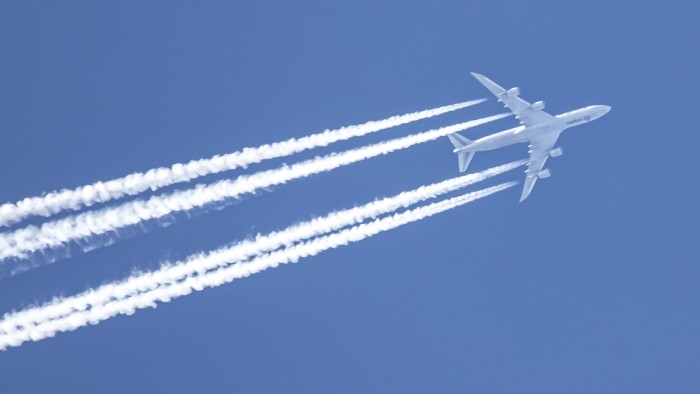Stay informed with free updates
Simply sign up to the Climate change myFT Digest — delivered directly to your inbox.
The writer is a researcher on carbon footprinting and global sustainability, professor at Lancaster University and Director of Small World Consulting
Tackling contrails, those silver streaks that form across both cold and humid skies, is the closest thing we have to a silver bullet to dramatically reduce the climate impact of aviation.
We all know that flying is bad for the environment, but what most people don’t realise is that its impact is nearly doubled by such “non-CO₂” emissions. Considered over a 100-year timeframe, 35-50 per cent of aviation’s total (CO₂ and non-CO₂) emissions can be attributed to contrails. But because they have an instant and intense effect, over a 20-year time frame they will be the dominant component of aviation’s climate impact.
The good news is that, unlike many other climate problems, there’s a simple, immediate and cost-effective way to tackle them. We would need to reroute less than 2 per cent of flights to halve their impact — that’s a huge reduction for very little effort. It’s also relatively cheap at just $5-$25 per tonne of CO₂ equivalent (compared to at least $185 per tonne of CO₂ equivalent for sustainable aviation fuels). And the technology is already in place: we’re getting better at predicting the weather conditions in which contrails form and altering flight plans accordingly.
Luckily the EU has now started to move forward on this, with all flights within the region reporting on their non-CO₂ impact from January 1 2025. This kind of monitoring is crucial to capture the data needed to understand which planes should be rerouted for the biggest cuts in emissions. But, with flights over North America, Europe and the north Atlantic accounting for more than half of global contrail impact, the US seriously needs to catch up. International flights leaving the EU will — eventually — be required to report their non-CO₂ impacts from January 1 2027. This was originally supposed to start this year, but was delayed after a number of airlines objected to the EU’s request to monitor their climate impact.
History tells us that this is no surprise. In 2012, the EU asked all airlines flying to and from the region to pay a modest amount for their CO₂ emissions. The response? Airlines for America, a trade body of US airlines, sued the EU to try to stop the legislation. While the highest EU court said the law was perfectly legal, the group onboarded John Thune (now Senate majority leader) to enact the European Union Emissions Trading System Prohibition Act in an attempt to prevent US airlines from complying with the EU law. But it never came to this, as the EU backed down in dramatic fashion and rushed through a pause on the legislation to appease Airlines for America.
Both the monitoring of non-CO₂ emissions and payments for CO₂ emissions are coming in from 2027 nonetheless. It’s too early to say whether Thune will still be majority leader and whether the EU will finally stand up to the US airlines shirking their responsibilities — but we can and must move forward with reducing the non-CO₂ impacts of aviation as quickly as possible.
The policy landscape is forming around CO₂ emissions, but there’s still plenty that policymakers need to do to act on contrails. This starts with making sure that these impacts are monitored and including contrail management as part of flight planning technology. Ensuring that aviation pays for its pollution is also key: currently, the industry does not pay fuel taxes and there are no charges for the climate impact caused outside the EU.
We undoubtedly need zero-emission technologies and fewer aeroplanes in our skies to clean up aviation, but contrail management has serious potential in the short term. The simple fact is that very few flights would need to change anything — by adjusting just 1.7 per cent of them, we could reduce contrail impact by over 60 per cent. It’s very hard to argue with that.
Read the full article here

